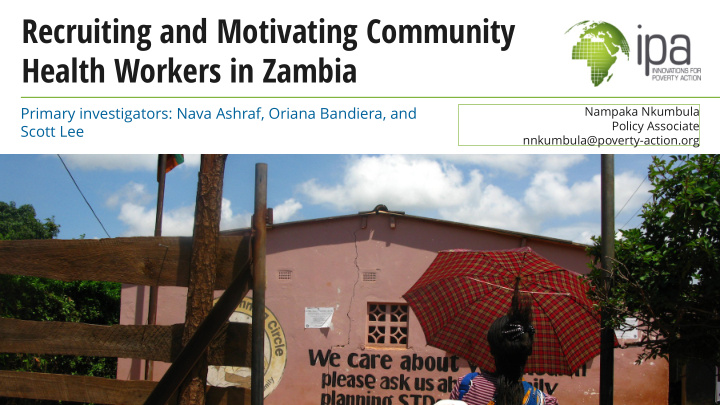



Recruiting and Motivating Community Health Workers in Zambia Primary investigators: Nava Ashraf, Oriana Bandiera, and Nampaka Nkumbula Policy Associate Scott Lee nnkumbula@poverty-action.org
Summary To recruit qualified community health assistants (CHAs), researchers and the Ministry of Health compared two strategies: Emphasizing social benefits (intrinsic motivation) • Emphasizing career benefits • They found that CHAs motivated by career benefits had better qualifications, performed better on the job, and resulted in improved health outcomes for the communities they served than those motivated by social benefits.
Policy Context Community health workers can help to address shortage of healthcare • providers. New civil service position created in 2010: the Community Health Assistant • (CHA) in an effort by the Ministry of Health to standardize CHW training and qualifications in communities. CHAs undergo a year of formal training, and then return to their • communities to work. They are the first line of healthcare for Zambians living in the most remote • regions of the country.
Research Question Ministry of Health partnered with researchers and IPA to evaluate strategies for recruiting • and motivating CHAs. The success of public services like the CHA program depends on the effort of the workers • who provide them. How do different incentives affect who self-selects into community health assistant jobs? • Effort can be increased in two ways: • Incentives that directly reward effort • Selection of workers predisposed towards exerting effort (high intrinsic motivation) • Which strategy attracts more qualified, higher-performing workers? •
Program Design Ministry of Health posted advertisements for CHA position in 48 districts in rural Zambia 48 districts randomly divided into two groups : Recruitment posters emphasizing social benefits of becoming a CHA • Serving one’s community and becoming a leader • Recruitment posters emphasizing career benefits of becoming a CHA • Opportunities for promotion and further professional development •
Program Design Aside from emphasis on benefits, recruitment materials and selection • processes were otherwise identical • Applicants needed to be Zambian nationals, age 18-45 • High school diploma and passing grades for at least 2 subjects on secondary school exams Government received over 2,400 applications • 314 applicants accepted and trained, 307 began work as CHAs •
Evaluation 2010-2014 • Researchers: • Nava Ashraf (London School of Economics and Political Science) • Oriana Bandiera (London School of Economics and Political Science) • Scott Lee (Harvard University) • Researchers used several data sources to determine which CHAs • were more effective : Data from mobile platform • Administrative records • Household surveys •
Background on IPA involvement Timeline • CHA recruitment: 2010 • CHA training: 2011-2012 • CHA midline survey: 2013 • Household endline survey 1: 2014 • Household endline survey 2: 2016-17
Results Workers drawn by career benefits were more effective CHAs than those drawn by social benefits. Performed 29 percent more household visits • Attended twice as many community meetings • More likely to use health facilities for childbirth (30%), health checks (24%), • child weighings (22%), and immunizations (20%) Significant increases in healthy practices among households they served • Breastfeeding, proper stool disposal, deworming treatment, immunization schedules • Children under 5 years old who had these CHAs were 5 percentage points • less likely to be underweight * As compared to “community” recruited CHAs
Policy Lessons 1. The ways in which workers self-select for public service jobs have significant effects on service provision. 2. Offering civil service positions with career opportunities attracts workers who deliver services with remarkable health impacts in their communities.
Impact The Ministry of Health and • The Clinton Health Access Initiative (CHAI) have used the career incentives posters to recruit, train, and deploy 1,400 CHAs nationwide. Given the Ministries current • targets this could reach 3, 400 in 2020.
Further Research 2016-17 Endline Full-sample endline evaluation: Visit all 307 CHAs from initial 2011-2012 cohort • 47 districts • 162 health posts • Conduct interviews with: • Households (16 per HP) • CHAs (1-2 per HP) • Health facility In-charge (1 per HP) • Collect administrative data from HMIS and ECZ •
Thank you This study was made possible by the generous support of, among others, the International Growth Centre (IGC) and the American people through the United States Agency for International Development (USAID). The contents are the responsibility of IPA and do not necessarily reflect the views of USAID or the United States Government. poverty-action.org
Recommend
More recommend